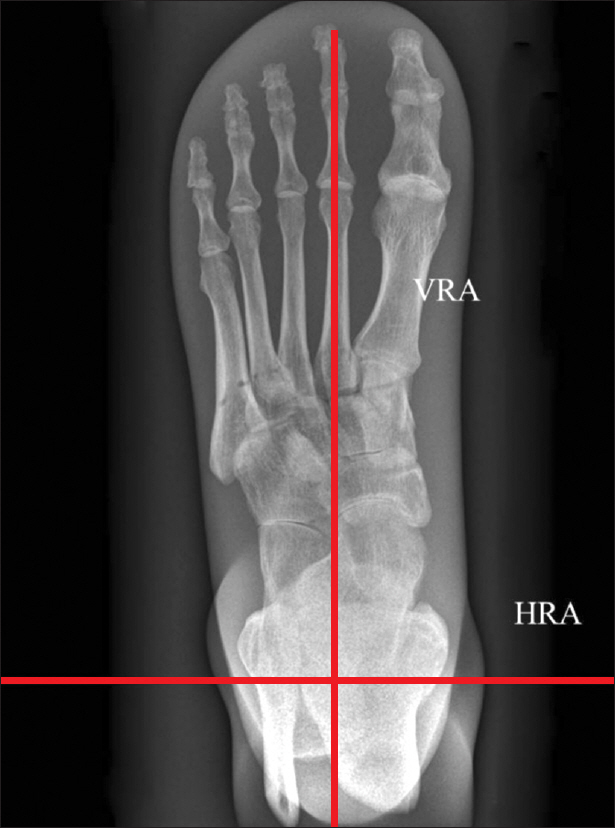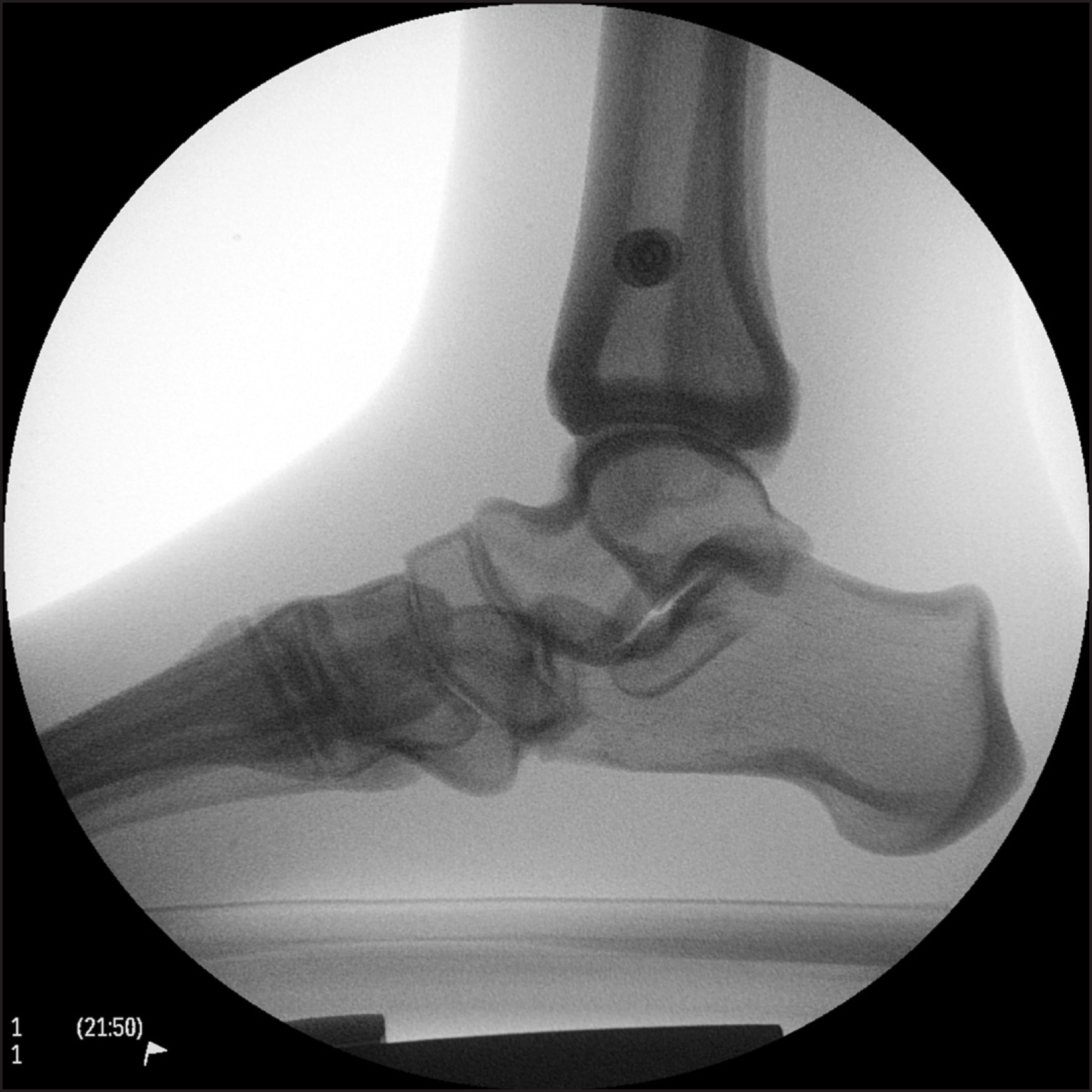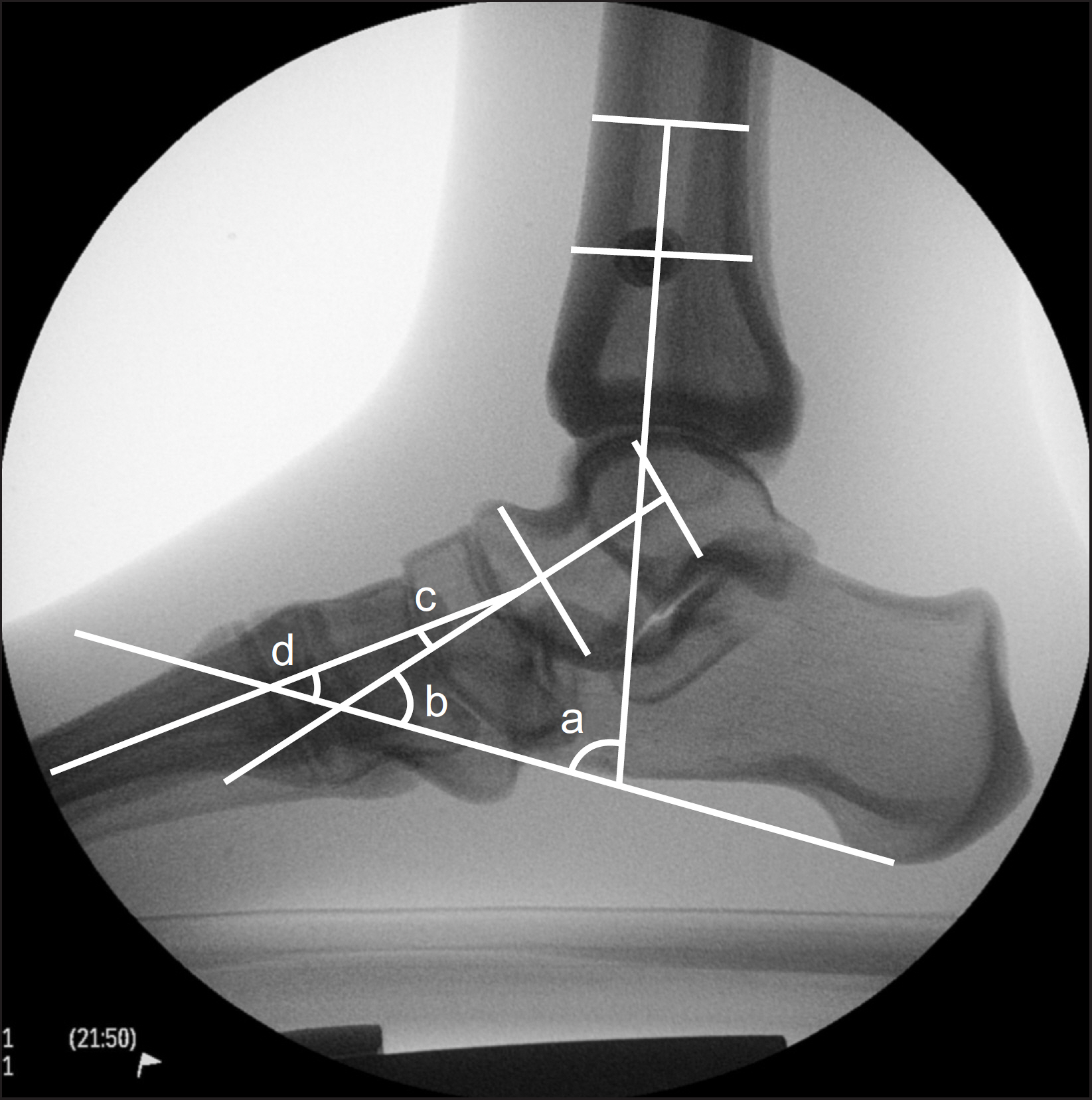J Korean Foot Ankle Soc.
2015 Dec;19(4):165-170. 10.14193/jkfas.2015.19.4.165.
Change of Radiologic Index of Foot according to Radiation Projection Angle: A Study Using Phantom Foot
- Affiliations
-
- 1Department of Orthopedic Surgery, Seoul National University Hospital, Seoul, Korea. leedy@snu.ac.kr
- 2Department of Orthopedic Surgery, Asan Medical Center, Seoul, Korea.
- KMID: 2132459
- DOI: http://doi.org/10.14193/jkfas.2015.19.4.165
Abstract
- PURPOSE
The purpose of this study is to analyze the measurement differences of simple radiographs according to radiation projection angle using a phantom and to propose methods for objective analysis of simple radiographs.
MATERIALS AND METHODS
We took simple radiographs with different projection angles using a C-arm image intensifier and measured five parameters of the foot on the simple radiographic images. Five parameters include lateral tibiocalcaneal angle, lateral talocalcaneal angle, naviculocuboid overlap, lateral talo-first metatarsal angle, and lateral calcaneo-first metatarsal angle. Intraobserver and interobserver reliability were verified, and then intraclass correlations of parameters were analyzed.
RESULTS
Radiographic parameters of the foot showed high intraobserver and interobserver reliability. Lateral tibiocalcaneal angle has a strong negative linear relationship with rotation and a moderate negative linear relationship with tilt. Lateral talocalcaneal angle has a moderate positive linear relationship with rotation and a strong positive linear relationship with tilt. Naviculocuboid overlap has a strong positive linear relationship with rotation and a moderate positive linear relationship with tilt. Lateral talo-first metatarsal angle does not have a linear relationship with rotation and a moderate negative linear relationship with tilt. Lateral calcaneo-first metatarsal angle has a moderate positive linear relationship with rotation and tilt.
CONCLUSION
More precise evaluation of the foot with a simple radiograph can be performed by understanding the changes of radiographic parameters according to radiation projection angle.
Keyword
Figure
Reference
-
References
1. Rankine JJ, Nicholas CM, Wells G, Barron DA. The diagnostic accuracy of radiographs in Lisfranc injury and the potential value of a craniocaudal projection. AJR Am J Roentgenol1. 2012; 198:W365–9.
Article2. Barg A, Amendola RL, Henninger HB, Kapron AL, Saltzman CL, Anderson AE. Influence of ankle position and radiographic projection angle on measurement of supramalleolar alignment on the anteroposterior and hindfoot alignment views. Foot Ankle Int. 2015; 36:1352–61.
Article3. Saltzman CL, Brandser EA, Berbaum KS, DeGnore L, Holmes JR, Katcherian DA, et al. Reliability of standard foot radiographic measurements. Foot Ankle Int. 1994; 15:661–5.
Article4. Noh KC, Shim JS, Kim SJ, Park SJ, Sung KS. Variability of radiographic measurements of bowleg deformity in children: a new method for metaphyseal diaphyseal angle (MDA). J Korean Orthop Assoc. 2003; 38:179–82.
Article5. Thomas JL, Kunkel MW, Lopez R, Sparks D. Radiographic values of the adult foot in a standardized population. J Foot Ankle Surg. 2006; 45:3–12.
Article6. Steel MW 3rd, Johnson KA, DeWitz MA, Ilstrup DM. Radiographic measurements of the normal adult foot. Foot Ankle. 1980; 1:151–8.
Article7. Lee DY, Seo SG, Kim EJ, Kim SJ, Lee KM, Farber DC, et al. Correlation between static radiographic measurements and intersegmental angular measurements during gait using a multisegment foot model. Foot Ankle Int. 2015; 36:1–10.
Article8. Wright JG, Feinstein AR. Improving the reliability of orthopaedic measurements. J Bone Joint Surg Br. 1992; 74:287–91.
Article9. Chen X, Gilkeson RC, Fei B. Automatic 3D-to-2D registration for CT and dual-energy digital radiography for calcification detection. Med Phys. 2007; 34:4934–43.
Article
- Full Text Links
- Actions
-
Cited
- CITED
-
- Close
- Share
- Similar articles
-
- Change of Radiologic Indicators during Putting Foot Orthosis on Flatfoot in Children with Cerebral Palsy
- A Study on Changes of the Foot Shape with the Weight Loading by One Foot
- The Effect of Foot Orthosis on Spinal Curvature by Correction of Foot Pronation and Limb Length Discrepancy
- Morphometrics of the Medial Longitudinal Arch of Foot in Korean
- The Talus-1st Metatarsal Angle, the Talo-Horizontal Angle and Calcaneal Pitch Angle of Young Men in Korea






